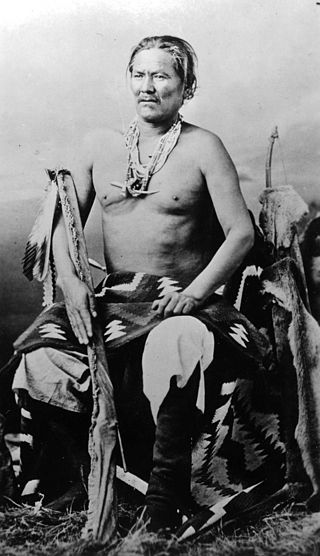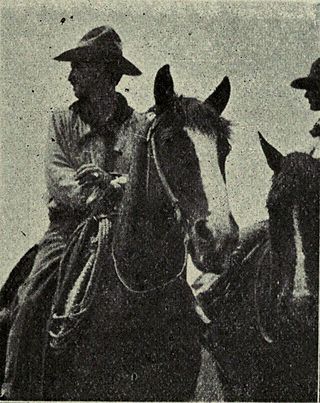Related Research Articles

The Long Walk of the Navajo, also called the Long Walk to Bosque Redondo, was the 1864 deportation and attempted ethnic cleansing of the Navajo people by the United States federal government. Navajos were forced to walk from their land in what is now Arizona to eastern New Mexico. Some 53 different forced marches occurred between August 1864 and the end of 1866. Some anthropologists claim that the "collective trauma of the Long Walk...is critical to contemporary Navajos' sense of identity as a people".
House Made of Dawn is a 1968 novel by N. Scott Momaday, widely credited as leading the way for the breakthrough of Native American literature into the mainstream. It was awarded the Pulitzer Prize for Fiction in 1969, and has also been noted for its significance in Native American anthropology.
Rudolph Carl Gorman was a Native American artist of the Navajo Nation. Referred to as "the Picasso of American Indian artists" by The New York Times, his paintings are primarily of Native American women and characterized by fluid forms and vibrant colors, though he also worked in sculpture, ceramics, and stone lithography. He was also an avid lover of cuisine, authoring four cookbooks, called Nudes and Food.

The Navajo are a Native American people of the Southwestern United States.

Dinétah is the traditional homeland of the Navajo tribe of Native Americans. In the Navajo language, the word "Dinétah" means "among the people" or "among the Navajo". In the geographical sense, Dinétah encompasses a large area of northwestern New Mexico, southwestern Colorado, southeastern Utah, and northeastern Arizona. The boundaries are inexact, and are generally marked by mountain peaks which correspond to the four cardinal directions.

William Penhallow Henderson was an American painter, architect, and furniture designer.

Henry Chee Dodge, also known in Navajo by his nicknames Hastiin Adiitsʼaʼii and Kiiłchííʼ, was the last official Head Chief of the Navajo Tribe from 1884 until 1910, the first Tribal Chairman of the Navajo Business Council from 1922 until 1928, and chairman of the then Navajo Tribal Council from 1942 until 1946. He was the father of Thomas Dodge, who served as Tribal Council chairman from 1932 until 1936, and activist Annie Dodge Wauneka.

Charles Sequevya Loloma was a Hopi Native American artist known for his jewelry. He also worked in pottery, painting and ceramics.
Peter Iverson was the Regents Professor of History (Emeritus) at Arizona State University. Iverson received his B.A. in 1967 from Carleton College; his M.A. in 1969, and Ph.D., 1975, from the University of Wisconsin–Madison where he studied with Al Bogue, Robert Berkhofer, Catharine McClellan, and Herb Lewis. He was awarded the Guggenheim Fellowship in 1999 and served as the President of the Western History Association. His primary area of research is Native American history in the 20th and 21st centuries.

Harrison Begay, also known as Haashké yah Níyá was a renowned Diné (Navajo) painter, printmaker, and illustrator. Begay specialized in watercolors, gouache, and silkscreen prints. At the time of his death in 2012, he was the last living, former student of Dorothy Dunn and Geronima C. Montoya at the Santa Fe Indian School. His work has won multiple awards and is exhibited in museums and private collections worldwide and he was among the most famous Diné artists of his generation.

The Navajo Times – known during the early 1980s as Navajo Times Today – is a newspaper created by the Navajo Tribal Council in 1959; in 1982 it was the first daily newspaper owned and published by a Native American Indian Nation. Now financially independent, it is published in English; its headquarters are located in Window Rock, Arizona.
Fernando Padilla Jr. is a Native American artist. His father was full blood San Felipe Pueblo and his mother is Navajo and Apache. Padilla is enrolled with the San Felipe Pueblo and is listed as half San Felipe Pueblo and half Navajo. Padilla was born in Huntington Park, California. He grew up in various places in New Mexico and Arizona due to his father's job with the U.S. Forestry Service. He moved to Oklahoma in 1978 and still lives there to date. Best known for his painting of the Southwestern landscape and Pueblo life, Padilla also creates multi-dimensional artwork, sculpture and jewelry.
Williams v. Lee, 358 U.S. 217 (1959), was a landmark case in which the Supreme Court of the United States held that the State of Arizona does not have jurisdiction to try a civil case between a non-Indian doing business on a reservation with tribal members who reside on the reservation, the proper forum for such cases being the tribal court.
Allen Raj was a Hopi artist and silversmith in Hopi silver overlay and stone inlay, featuring the lapidary genres of commesso and intarsia. Sekaquaptewa used colorful stones and shell for his Hopi silver overlay, not only plain silver decorated with chisel strokes on black oxide surfaces, a Hopi-signature technique known as matting.
Alice Williams Cling is a Native American ceramist and potter known for creating beautiful and innovative pottery that has a distinctive rich reds, purples, browns and blacks that have a polished and shiny exteriors, revolutionizing the functional to works of art. Critics have argued that she is the most important Navajo potter of the last 25 years.
Rose Williams was a Navajo potter credited with renewing interest in the Navajo pottery tradition.
Christine McHorse, also known as Christine Nofchissey McHorse, was a Navajo ceramic artist from Santa Fe, New Mexico.
Jim Abeita is a Navajo oil painter from Crownpoint, New Mexico. He is best known for his realistic landscapes and portraits depicting his native people and their history and traditions. He was one of the first Native American artists to work in contemporary realism, painting with depth and shadow instead of in the flat-style traditional Native American art. Abeita is praised as a pioneering artist who modernized the Native American art scene, made it famous in the art market and paved the way for a new generation of artists.

Dr. Carl Nelson Gorman, also known as Kin-Ya-Onny-Beyeh (1907–1998) was a Navajo code talker, visual artist, painter, illustrator, and professor. He was faculty at the University of California, Davis, from 1950 until 1973. During World War II, Gorman served as a code talker with the United States Marine Corps in the Pacific.
Robert D. Draper was a Navajo (Diné) and Hopi/Laguna contemporary artist, known for his watercolor paintings. He often painted realistic landscapes of the Navajo (Diné) Reservation and Canyon de Chelly.